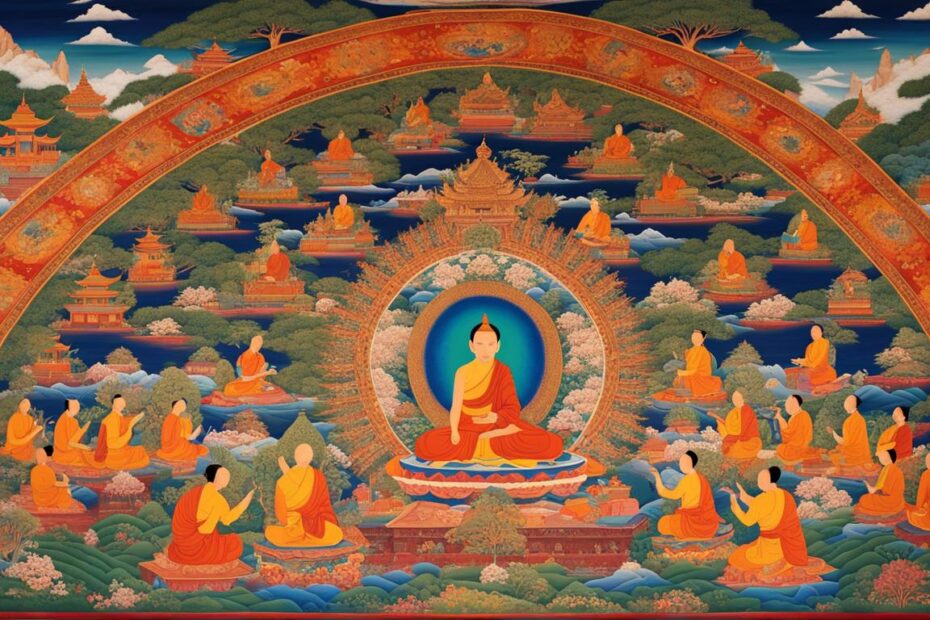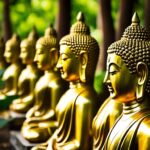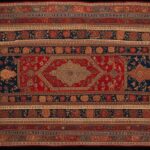Thangka paintings are a captivating form of Tibetan art that has deep roots in Buddhist and Tibetan traditions. Highly revered as spiritual and cultural treasures, Thangkas showcase intricate details and vibrant colors, embodying the essence of Tibetan culture and spirituality. In this article, we will delve into the history, significance, symbolism, materials, and use of Thangka paintings, offering a glimpse into the mesmerizing world of this traditional art form.
Key Takeaways:
- Thangka paintings are a significant part of Tibetan art and culture.
- They showcase intricate details and vibrant colors.
- Thangkas are highly revered as spiritual and cultural treasures.
- They have deep roots in Buddhist and Tibetan traditions.
- Thangka art offers a glimpse into the rich tradition and artistry of Tibet.
The Origins and Evolution of Thangka Paintings
Thangka paintings have a rich history rooted in Buddhist and Tibetan traditions. Emerging in the 7th century in Tibet, these paintings were originally created as portable devotional artworks used for teaching and meditation. Over time, Thangkas spread across the Himalayan region and underwent stylistic developments, incorporating influences from various cultural and artistic traditions.
Thangka paintings play a significant role in preserving cultural heritage and continue to impact global artistic movements. They have evolved into a diverse range of regional styles, each with unique characteristics and iconographic elements. These paintings showcase intricate details and vibrant colors, reflecting the spiritual and cultural significance they hold.
Throughout their evolution, Thangka paintings have remained deeply connected to Buddhist and Tibetan traditions. They serve as visual representations of profound spiritual concepts and teachings, inviting viewers to engage with the imagery on a deeper level. The origins and evolution of Thangka paintings highlight their cultural impact and the enduring legacy of this captivating art form.
Table: Regional Styles of Thangka Paintings
| Region | Characteristics |
|---|---|
| Tibet | Ancient symbolism, vibrant colors, and intricate details |
| Nepal | Influenced by Newar art, harmony in proportions and color palette |
| Bhutan | Incorporates elements of Tibetan and Indian art, stylized figures |
| India | Strong influence of Indian art, refined brushwork and attention to detail |
| Ladakh | Blend of Tibetan and Indian styles, elaborate landscapes |
Materials and Techniques Used in Thangka Paintings
Thangka paintings are meticulously created using traditional materials and techniques that have been passed down through generations. These materials and techniques contribute to the unique beauty and durability of Thangka art.
The canvas used for Thangka paintings is typically made of cotton or silk. Before the painting process begins, the canvas is carefully prepared with layers of gesso and glue. This preparation provides a stable foundation for the pigments and ensures the longevity of the artwork.
The pigments used in Thangka paintings are derived from natural sources such as minerals, plants, and precious metals. These pigments are ground into fine powders and then mixed with a binder to create vibrant colors. Gold leaf or gold paint is often used to add a luminous quality to certain elements of the artwork.
Thangka artists undergo years of training to master the intricate brushwork, precise line work, and attention to detail required for creating these artworks. The brushwork can vary in thickness and pressure, creating texture and depth in the final piece. The precision and skill of the artist are essential in capturing the intricate details and symbolism of Thangka art.
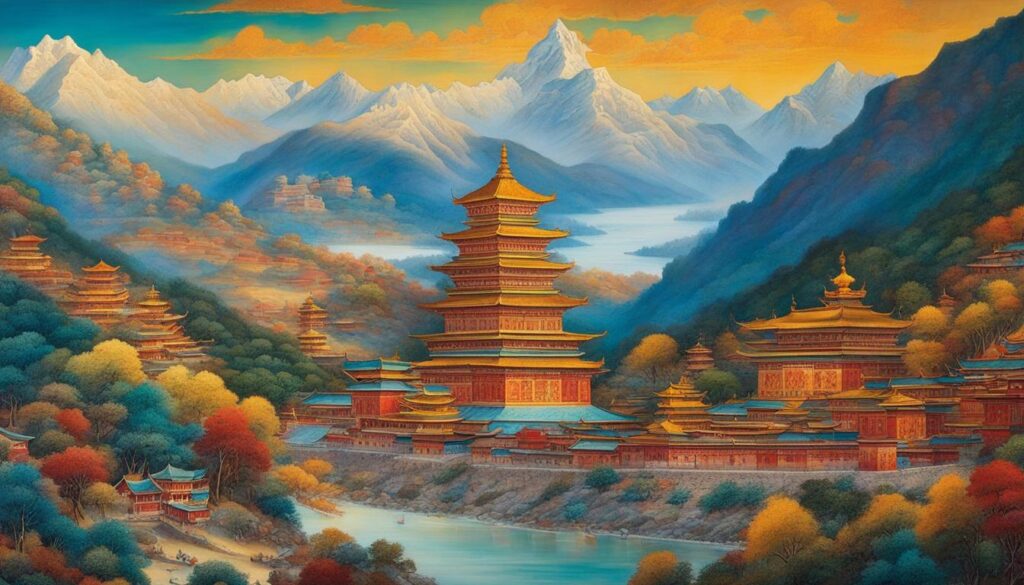
Table: Comparison of Materials and Techniques Used in Thangka Paintings
| Materials | Techniques |
|---|---|
| Canvas | Cotton or silk fabric |
| Pigments | Natural sources: minerals, plants, precious metals |
| Preparation | Layered gesso and glue |
| Gold Leaf/Paint | Adds luminosity and richness |
| Brushwork | Intricate and precise brush techniques |
The combination of these materials and techniques results in the stunning beauty and intricate details that characterize Thangka paintings. The use of traditional methods ensures the preservation of the rich heritage and cultural significance of Thangka art.
Symbolism in Thangka Art
Thangka paintings are rich in symbolism, which plays a crucial role in conveying profound spiritual concepts and teachings. Each element within a Thangka carries symbolic meaning, inviting viewers to engage with the imagery on a deeper level. In Thangka art, deities and Buddhas are depicted with distinct characteristics and gestures that represent their unique qualities and teachings.
The use of colors in Thangka paintings also holds significant symbolism. Different colors represent specific virtues and qualities associated with the depicted figures. For example, blue symbolizes wisdom and purity, while red represents transformation and compassion. Gold is often used to depict the divine and signifies luminosity and enlightenment.
Mandalas, intricate geometric patterns, are another important symbolic element in Thangka art. Mandalas represent the universe and serve as visual aids for meditation and spiritual transformation. They provide a visual framework for practitioners to focus their attention and explore the interconnectedness of all phenomena.
Thangka art showcases the deep symbolism of Buddhist iconography, inviting viewers to contemplate the teachings and cultivate a deeper understanding of spiritual concepts.
Ritual and Devotional Use of Thangka Paintings
Thangka paintings are not only admired for their symbolism, but they also hold great significance in religious ceremonies and devotional practices. They serve as focal points for meditation, prayer, and visual contemplation, allowing individuals to connect with the divine presence represented in the artwork.
During religious festivals and ceremonies, Thangkas are displayed and venerated, creating a sacred atmosphere that enhances the spiritual experience. Thangka paintings are also used as aids for visualization practices and deity yoga, where practitioners imagine themselves as the depicted deities to cultivate a sense of connection and devotion.
The ritual and devotional use of Thangka paintings deepen one’s spiritual practice and provide a tangible way to connect with the teachings and qualities represented in the artwork.
Themes and Subjects in Thangka Paintings
Thangka paintings encompass a wide range of subjects and themes connected to Buddhist iconography. These intricate artworks depict various figures, landscapes, and narratives that hold great significance in Tibetan culture and spirituality. The following table provides an overview of the common themes and subjects found in Thangka paintings:
| Themes | Subjects |
|---|---|
| Buddhist Iconography | Buddhas, Bodhisattvas, enlightened masters, celestial beings |
| Landscape | Sacred landscapes, mythical abodes of gods, realms of existence |
| Epic Tales | Scenes from Buddhist folklore, historical events related to Buddhism |
Thangka paintings often depict Buddhas and Bodhisattvas, who represent different aspects of enlightenment, compassion, and wisdom. These figures embody the teachings and qualities to be cultivated on the path to liberation. Additionally, Thangkas showcase sacred landscapes that provide contextual understanding of Buddhist cosmology and serve as visual aids for meditation. These landscapes depict mythical realms and celestial abodes where deities reside.
Thangkas also portray scenes from epic tales, folklore, and historical events related to the spread of Buddhism. These narrative depictions offer visual storytelling of significant moments, teachings, and legendary figures in Buddhist history. They serve as tools for conveying the rich cultural and spiritual heritage of Tibetan and Himalayan communities.
While the themes and subjects in Thangka paintings remain consistent across various sects of Tibetan Buddhism, there may be slight variations in the iconography and interpretations. Different lineages within Tibetan Buddhism may emphasize specific deities, teachings, or historical events, resulting in variations in the subjects depicted in Thangkas.
Ritual and Devotional Use of Thangka Paintings
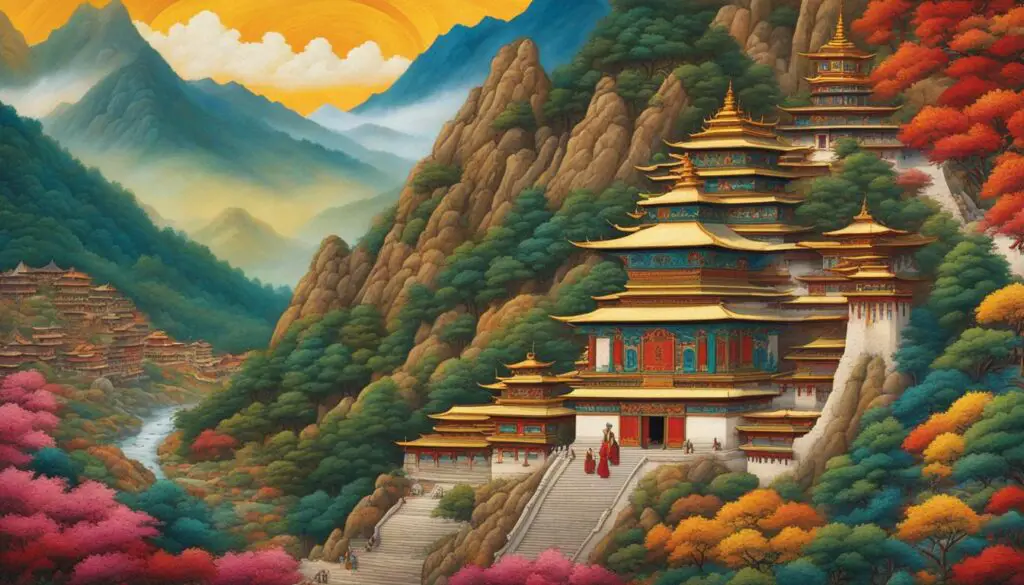
Thangka paintings hold a significant role in religious ceremonies, rituals, and devotional practices within Tibetan and Himalayan cultures. They are considered sacred objects that serve as focal points for meditation, prayer, and visual contemplation. Thangkas are displayed and venerated during religious festivals and ceremonies, allowing devotees to connect with the divine presence represented in the artwork.
These intricate artworks are not just passive objects; they actively participate in the spiritual lives of practitioners. Thangkas are used as aids for visualization practices and deity yoga, where practitioners imagine themselves as the depicted deities to cultivate a sense of connection and devotion. By engaging with the sacred imagery in Thangka paintings, individuals can deepen their spiritual understanding and strengthen their connection with the divine.
The ritual use of Thangka paintings also extends beyond personal practices to communal activities. Monasteries and temples display elaborate Thangkas during religious events, creating a visual feast for devotees. The presence of these vibrant artworks is believed to invoke blessings and purify the environment, enhancing the spiritual atmosphere. Thangkas serve as a bridge between the physical and spiritual realms, facilitating a deeper engagement with the divine and fostering a sense of awe and reverence.
The Main Prayer Tools
When engaging with Thangka paintings for devotional purposes, practitioners often use prayer tools as aids in their rituals. These tools may include:
- Malas: Prayer beads used for counting mantras and cultivating mindfulness.
- Butter Lamps: Lit to symbolize the dispelling of darkness and the offering of light to the divine.
- Incense: Burned as an offering to purify the environment and create a fragrant atmosphere.
- Offering Bowls: Filled with water or other substances as a symbol of offering and generosity.
These prayer tools complement the contemplative experience of engaging with Thangka paintings, creating a multisensory journey of devotion and connection.
| Thangka Sects | Variations in Ritual Use |
|---|---|
| Gelugpa | Emphasizes the use of mantras and meditative visualizations during Thangka rituals. |
| Kagyu | Focuses on the experiential aspect of Thangka meditation, emphasizing direct realization. |
| Nyingma | Embraces a wide range of ritual practices, including complex visualizations and mantra recitation. |
| Sakya | Places importance on the empowerment and blessing rituals associated with Thangka paintings. |
“When I sit in front of a Thangka painting, I feel a deep sense of connection with the divine. It guides me on my spiritual journey and helps me cultivate devotion and mindfulness.” – Devotee
The ritual use of Thangka paintings has been passed down through generations, evolving and adapting to different cultural and regional contexts. The practices surrounding Thangka art continue to be central to the spiritual lives of individuals and communities, fostering a sense of deep connection, reverence, and devotion.
Conservation and Preservation of Thangka Paintings
Thangka paintings are not only exquisite works of art but also fragile artifacts that require careful conservation and preservation to ensure their longevity. These delicate pieces carry immense cultural and spiritual significance, making it crucial to implement proper handling, storage, and restoration techniques.
Conservation efforts for Thangka paintings involve specialized experts who employ a combination of scientific techniques and traditional methods. They meticulously examine and analyze the condition of the artwork, identifying any signs of deterioration or damage. Depending on the severity of the issues, various restoration techniques may be employed, such as consolidating flaking paint, repairing tears, or cleaning the surface to remove dirt or stains.
Furthermore, guidelines and protocols have been established to ensure the proper handling, storage, and display of Thangka paintings. Exposure to light and fluctuations in temperature and humidity can cause irreversible damage to these fragile artworks. Therefore, conservationists recommend using archival-quality materials and implementing controlled environmental conditions to protect Thangka paintings from deterioration.
| Conservation Techniques | Storage Recommendations | Restoration Methods |
|---|---|---|
| Consolidation of flaking paint | Use acid-free folders or boxes | Repairing tears or damages |
| Surface cleaning to remove dirt or stains | Avoid direct exposure to sunlight | Retouching damaged areas |
| Repairing tears or damages | Maintain stable temperature and humidity levels | Conservation varnishing |
“Thangka paintings are not mere artworks; they are cultural and spiritual treasures that require our utmost care and attention. Through proper conservation and preservation, we can ensure that these precious creations continue to inspire and educate future generations.” – Conservation expert
Evolution of Conservation Techniques
Conservation methods for Thangka paintings have evolved over time, blending traditional knowledge with scientific advancements. Initially, restoration techniques focused primarily on stabilizing and repairing damages. However, with the progress in conservation technology, new approaches and materials have been introduced, enabling conservators to address the unique challenges posed by Thangka paintings more effectively.
In recent years, digital imaging techniques have also been utilized to document the condition of Thangka paintings and facilitate the restoration process. High-resolution photographs and infrared imaging can reveal hidden layers, faded pigments, and previous restorations, aiding in accurate analysis and decision-making.
Conservation organizations, museums, and private collectors around the world are actively involved in preserving Thangka paintings, ensuring that these invaluable artworks continue to be appreciated for generations to come.
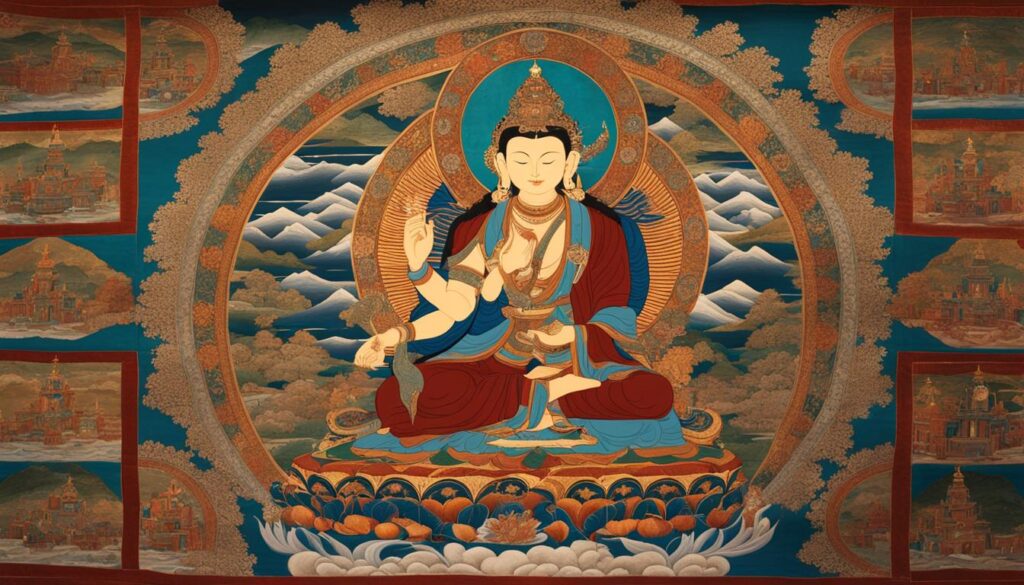
The Cultural Significance of Thangka Art
Thangka art holds immense cultural significance, serving as a powerful expression of devotion and a testament to the spiritual and artistic traditions of Tibetan culture. These intricately painted artworks are revered for their beauty and their ability to convey profound teachings and spiritual concepts.
The creation and appreciation of Thangka art are deeply rooted in Buddhist beliefs and practices. Thangkas are considered sacred objects that invite contemplation and serve as visual aids for meditation and spiritual transformation. They depict deities, Buddhas, and celestial beings, each with their own symbolic meanings and teachings. The vibrant colors, precise brushwork, and intricate details of Thangkas draw viewers into a world of spirituality and inspire a sense of awe and reverence.
Thangka art is not only a reflection of spiritual devotion but also an important part of Tibetan cultural heritage. These paintings offer insights into the beliefs, values, and artistic sensibilities of the communities that created and cherished them. Thangkas serve as visual records of historical events, folklore, and the spread of Buddhism. They are a tangible link to the past and a testament to the enduring legacy of Tibetan culture.
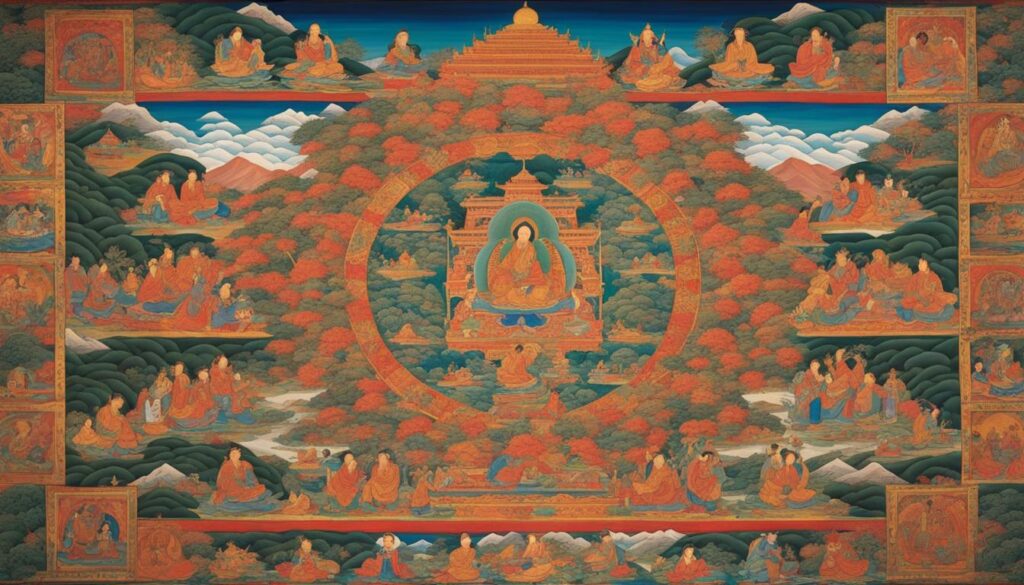
Table: Variations in Thangka Art Across Sects
| Sect | Characteristics |
|---|---|
| Gelug | Emphasizes precise iconography and strict adherence to traditional styles. |
| Kagyu | Known for dynamic and expressive depictions of deities and a focus on inner experience. |
| Nyingma | Features richly symbolic and detailed paintings, often incorporating elements of Tibetan folklore. |
| Sakya | Showcases precise line work and vibrant colors, often depicting the lineage of Sakya masters. |
Thangka art has evolved over time, reflecting the changing cultural and artistic influences in the Himalayan region. While the basic techniques and materials remain consistent, there have been innovations in style and subject matter. Contemporary interpretations of Thangka art have emerged, blending traditional techniques with modern expressions. This allows for cross-cultural dialogues and a broader appreciation of the spiritual and artistic significance of Thangka art.
Thangka Paintings and Buddhism
Thangka art plays a significant role in the practice and representation of Buddhism. These intricate paintings serve as visual representations that aid in meditation and spiritual practice. Thangkas depict various aspects of the Buddha’s life, stages of enlightenment, and the path to liberation. Through detailed imagery and symbolic representations, Thangkas assist practitioners in deepening their understanding of Buddhist philosophy and cultivating qualities such as compassion, wisdom, and mindfulness.
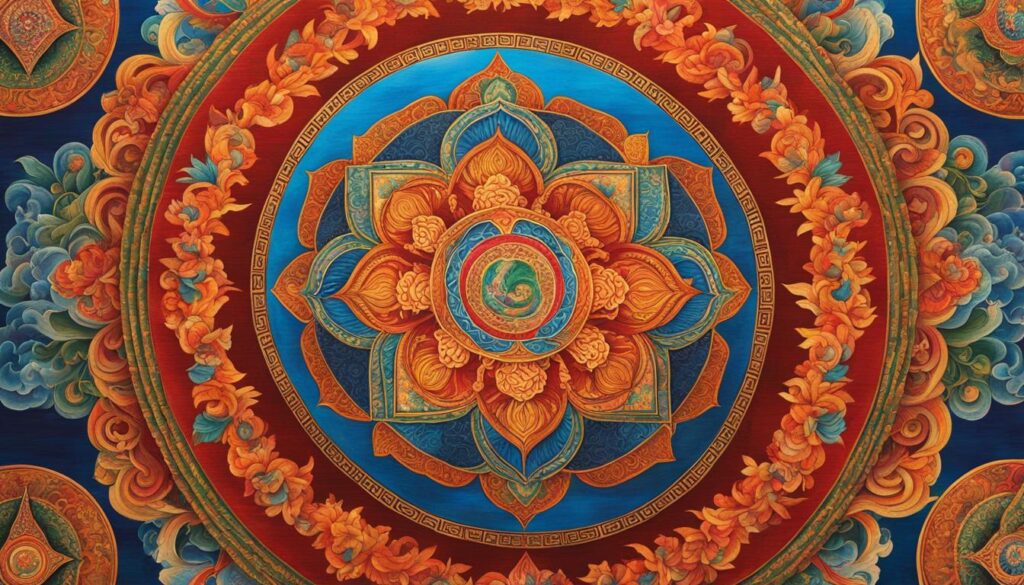
Thangka paintings are often used as focal points for meditation, allowing practitioners to focus their attention and cultivate a sense of calm and tranquility. The detailed and vibrant imagery found in Thangkas creates a visual representation of the teachings and ideals of Buddhism, serving as a reminder of the path to enlightenment.
Buddhist Symbolism in Thangka Art
Thangkas are rich in symbolism, with each element carefully chosen to convey specific spiritual teachings. The deities, Buddhas, and enlightened beings depicted in Thangka art represent different qualities and teachings, serving as guides and sources of inspiration for practitioners. The colors used in Thangkas also hold symbolic significance, representing virtues such as wisdom, compassion, and purity. Mandalas and sacred geometry further enhance the symbolic value of Thangka art, providing visual aids for meditation and spiritual transformation.
Over time, Thangka paintings have undergone stylistic developments and variations among different Buddhist sects. While the overall symbolism remains consistent, specific iconographic elements and interpretations may differ. These variations give each Thangka painting a unique character and offer practitioners multiple perspectives on their spiritual journey.
The Evolution and Materials of Thangka Paintings
The art of Thangka painting has evolved over centuries, incorporating different influences and styles. From its humble beginnings as portable devotional artworks, Thangkas have become intricate masterpieces that showcase the skill and craftsmanship of the artists. The materials used in Thangka paintings have also evolved, with the canvas typically made of cotton or silk, and natural pigments derived from minerals, plants, and precious metals creating vibrant colors. Gold leaf or gold paint is often used to add a luminous quality, reflecting the sacred nature of the artwork.
| Prayer Tools | Symbolism |
|---|---|
| Thangka Paintings | Visual representation of Buddhist teachings and ideals |
| Mala Beads | Used for counting mantras and focusing the mind during meditation |
| Prayer Wheels | Aid in the recitation of prayers and the spreading of positive energy |
| Butter Lamps | Symbolize the light of wisdom and the dispelling of ignorance |
Thangka art has not only preserved the rich traditions of Buddhism but also served as a means of spiritual expression and contemplation. As practitioners engage with Thangka paintings, they are reminded of the profound teachings of Buddhism and are inspired to cultivate qualities that lead to enlightenment.
Thangka Art in Modern Times
Thangka art, with its rich tradition and spiritual significance, continues to thrive and evolve in the modern world. Artists and collectors alike are drawn to the intricacy, spirituality, and cultural richness of Thangka paintings. Contemporary interpretations of Thangka art push boundaries and foster artistic dialogue, transcending cultural limitations.
The fusion of traditional techniques with contemporary approaches has given rise to innovative expressions of Thangka art. Artists experiment with different styles, materials, and subjects, breathing new life into this ancient art form. Through their artwork, they bridge the gap between the past and the present, honoring tradition while embracing the freedom and creativity of modern times.
In the global art scene, Thangka paintings are not confined to temples and monasteries. They are now displayed in art galleries, museums, and private collections worldwide. This broad exposure enhances cross-cultural exchanges and contributes to a greater understanding and appreciation of different artistic traditions.
Innovative Interpretations
The contemporary interpretations of Thangka art often challenge traditional boundaries, pushing the limits of form and content. Artists experiment with new styles and techniques while staying true to the core principles and symbolism of Thangka paintings. These reinterpretations provide fresh perspectives and offer glimpses into the evolving cultural landscape.
Thangka artists explore themes beyond traditional Buddhist iconography, incorporating elements from diverse artistic traditions and contemporary issues. This artistic dialogue fosters a deeper understanding and appreciation of Thangka art, transcending cultural barriers and promoting global artistic diversity.
Preserving Cultural Heritage
The modern appreciation of Thangka art plays a vital role in preserving cultural heritage. By recognizing the artistic and spiritual value of Thangka paintings, collectors and enthusiasts contribute to the continuation of this ancient tradition. Investments in authentic Thangka artworks support the livelihoods of talented artists and help sustain the cultural legacy for future generations.
| Benefits of Thangka Art in Modern Times | Challenges in the Modern Era |
|---|---|
| Revitalization of traditional art forms | Preserving authenticity amidst commercialization |
| Promotion of cross-cultural understanding | Adapting to changing artistic trends |
| Exploration of new artistic techniques | Maintaining the integrity of traditional symbolism |
Thangka art in modern times reflects the resilience and adaptability of culture and artistic expression. As the world evolves, so does the vibrant world of Thangka art, connecting people across continents and bridging cultural boundaries.
Collecting and Appreciating Thangka Art
Collecting Thangka art is a deeply enriching experience, offering art enthusiasts and spiritual seekers the opportunity to connect with the profound spirituality and cultural heritage represented in these sacred paintings. The authenticity and craftsmanship of each Thangka painting are crucial factors to consider when building a collection. Authentic Thangkas are created by skilled artists who have undergone rigorous training in the traditional techniques and have a deep understanding of the spiritual teachings and symbolism. Investing in authentic Thangka art not only ensures the preservation of this ancient art form but also allows collectors to engage with the spiritual teachings encapsulated within each artwork.
The craftsmanship displayed in Thangka art is truly exceptional. Every stroke of the brush, every line, and color choice is deliberate and serves a specific purpose in conveying the spiritual messages contained within the artwork. The level of detail and precision achieved by Thangka artists is awe-inspiring, and it is through careful attention to these intricacies that collectors can connect deeply with the spiritual essence of the painting. Each Thangka is a gateway to a world of spiritual teachings and practices, inviting viewers to contemplate and explore the profound wisdom embedded in the artwork.
The Symbolism and Spiritual Teachings of Thangka Art
Thangka art is not only visually captivating but also rich in symbolism. Every element depicted in a Thangka carries deep spiritual significance. From the positioning of deities to the colors used, each choice is deliberate and serves to convey specific spiritual teachings. Collectors have the opportunity to delve into the symbolic world of Thangka art and explore the profound meaning behind the imagery. By immersing themselves in the symbolism, collectors can gain a deeper understanding of Buddhist philosophy and the path to enlightenment.
| Thangka Art | Authenticity | Craftsmanship | Spiritual Teachings | Aesthetics |
|---|---|---|---|---|
| Collecting Thangka art allows individuals to connect with the spirituality and cultural heritage represented in these sacred paintings. | Authentic Thangkas are created by skilled artists who have undergone rigorous training in traditional techniques. | The craftsmanship displayed in Thangka art is truly exceptional, with every stroke and detail serving a specific purpose. | Thangka art carries deep spiritual teachings, inviting collectors to delve into the symbolism and contemplate the profound wisdom embedded in the artwork. | The aesthetics of Thangka art are visually captivating, showcasing vibrant colors and intricate details that engage the senses. |
Conclusion
In conclusion, Thangka art holds immense spiritual significance and is a testament to the rich cultural heritage of Tibet and the Himalayan region. These captivating paintings not only serve as visual representations of profound spiritual concepts but also embody the devotion, wisdom, and enlightenment sought in Buddhist practice.
Thangka art carries profound symbolism, inviting viewers to engage with the imagery on a deeper level. Each element within a Thangka, from the deities and Buddhas to the colors and mandalas, conveys unique qualities and teachings, facilitating meditation and spiritual transformation.
Over time, Thangka art has evolved, incorporating various influences and styles while remaining deeply rooted in tradition. The materials and techniques used, such as canvas, pigments, and intricate brushwork, showcase the mastery and dedication of Thangka artists.
Thangka art is a treasure trove of cultural heritage that continues to inspire and enchant people worldwide. These sacred paintings connect us to the beauty and wisdom of Tibetan culture, bridging the gap between the physical and spiritual realms. The legacy of Thangka paintings serves as a reminder of the profound spiritual significance art holds and its ability to preserve and transmit cultural traditions for generations to come.
FAQ
What are Thangka paintings?
Thangka paintings are a form of Tibetan art that originated in the 7th century. They are highly revered as spiritual and cultural treasures, showcasing intricate details and vibrant colors.
What materials are used in Thangka paintings?
Thangka paintings are meticulously created using traditional materials such as cotton or silk as the canvas. Natural pigments derived from minerals, plants, and precious metals are ground into fine powders and mixed with a binder to create vibrant colors. Gold leaf or gold paint is often used to add a luminous quality.
What is the significance of Thangka art?
Thangka paintings serve as visual representations of profound spiritual concepts and teachings. Every element within a Thangka carries symbolic meaning, inviting viewers to engage with the imagery on a deeper level. They also hold immense cultural significance, particularly in regions influenced by Tibetan Buddhism.
What subjects are depicted in Thangka paintings?
Thangka paintings encompass a wide range of subjects connected to Buddhist iconography. Common subjects include Buddhas, Bodhisattvas, enlightened masters, and celestial beings. Thangkas may also depict sacred landscapes, mythical abodes of the gods, and realms of existence within Buddhist cosmology.
How are Thangka paintings used in religious ceremonies?
Thangka paintings are considered sacred objects that serve as focal points for meditation, prayer, and visual contemplation. They are displayed and venerated during religious festivals and ceremonies, allowing devotees to connect with the divine presence represented in the artwork. Thangkas are also used as aids for visualization practices and deity yoga.
How are Thangka paintings conserved and preserved?
Thangka paintings are fragile artworks that require careful conservation and preservation. Specialized experts use scientific techniques and traditional methods to repair and stabilize damaged Thangkas. Guidelines and protocols are established for handling, storage, and display to ensure their longevity.
What is the cultural significance of Thangka art?
Thangka art holds immense cultural significance, preserving cultural heritage and transmitting religious teachings, folklore, and historical events. They offer insights into cultural beliefs, values, and artistic sensibilities, serving as visual records of the communities that created and cherished these artworks.
How does Thangka art relate to Buddhism?
Thangka art is deeply intertwined with Buddhism and serves as a visual aid to support spiritual practice. Thangkas represent the Buddha’s life, stages of enlightenment, and the path to liberation. They assist in deepening understanding of Buddhist philosophy and cultivating qualities such as compassion, wisdom, and mindfulness.
How does Thangka art continue to thrive in modern times?
Thangka art transcends cultural boundaries and continues to captivate art enthusiasts worldwide. Contemporary artists and collectors are drawn to the intricacy, spirituality, and cultural richness of Thangka paintings. Global appreciation and cross-cultural exchanges contribute to a broader understanding and appreciation of different cultural traditions.
What should I consider when collecting Thangka art?
When collecting Thangkas, it is essential to consider their authenticity, craftsmanship, and the lineage of the artist. Appreciating Thangka art involves immersing oneself in the intricate details, symbolism, and spiritual teachings conveyed through the artwork. Thangka paintings offer a unique opportunity to connect with spirituality and cultural heritage.


